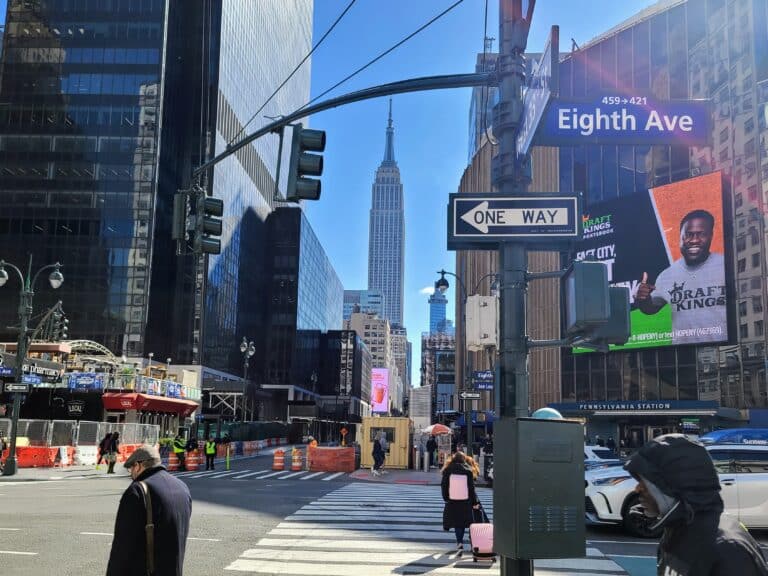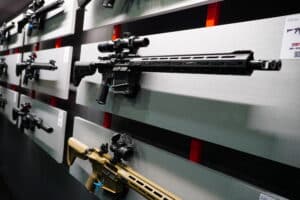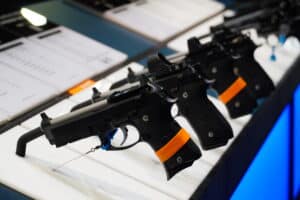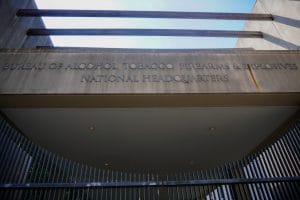New York’s ban on carrying firearms in its most iconic intersection can continue.
U.S. District Judge Nelson Roman ruled on Monday the gun-free zone that covers several city blocks in midtown Manhattan does not violate the Second Amendment. He cited two founding era bans on taking guns to “fairs” or “markets,” though one was against terrorizing people, and several late 19th century laws as analogues to the modern ban. He ruled those constituted a historical tradition in line with the standard set in the Supreme Court’s Bruen ruling.
“The Court is therefore persuaded by the Defendants’ argument that N.Y. Penal Law § 265.01-e(2)(n) is in line with the historical tradition of banning firearms in locations where large groups of people are congregated for commercial, social, and cultural activities,” he wrote in Frey v. Nigrelli. “These laws appear to recognize that the presence of groups of people, often in confined spaces, renders a location uniquely vulnerable to firearm violence.”
Judge Roman found the state’s prohibition against carrying on the subway system similarly defensible. He could not find any historical laws similar to the public transit ban but said that, since subway systems didn’t exist at the founding, taking a broader view was justified. He pointed primarily to private train company gun regulations as evidence New York’s ban is constitutional.
“Taking the ‘nuanced approach’ required in this context of the MTA subway and rails, the Court finds that an adequately (SIC) analogy could be made between (i) the fact that historically, the rail systems were privately owned and that ‘[p]rivate transportation companies possessed the power to create their own reasonable customer/passenger rules, which in at least some instances included prohibitions against the presence of guns in passenger cars’ and (ii) the fact the MTA subway and rails are government owned and operated, and therefore the government as proprietor can impose its own restrictions on gun-carrying upon its passengers.”
The ruling represents a rare win for New York over its post-Bruen gun-carry restrictions. Multiple other federal judges have struck down different provisions of the state’s carry law since it passed last year. The expansive reading of what regulations are allowed under the Supreme Court’s precedent will enable New York to continue enforcing most of its law while the Second Circuit Court of Appeals stays the other rulings against it.
Much of Judge Roman’s ruling relies on the idea that the government can ban guns from any public space that is sufficiently crowded. In both his discussion of Times Square and the subway, he pointed to the number of people who congregate in those areas.
“The State Defendants point to the same laws described above in the N.Y. Penal Law § 265.01-e(2)(t): Times Square (Discussion II.A.4.a, supra), arguing that there is a historical tradition of banning firearms in highly crowded locations where the risk of violence is high,” Judge Roman wrote. “While those laws do not relate to public transportation, the Court does find persuasive Defendants’ argument that N.Y. Penal Law § 265.01-e(2)(n) is consistent with those laws, considering that a main concern animating the gun restrictions in the MTA subways and rails is the high amount of foot traffic and related safety issues.”
The Supreme Court addressed “sensitive places” restrictions to some degree in Bruen. It said gun-free zones did exist during the founding era and left open the possibility that some modern restrictions that aren’t identical to those are still permissible.
“Although the historical record yields relatively few 18th- and 19th-century ‘sensitive places’ where weapons were altogether prohibited—e.g., legislative assemblies, polling places, and courthouses—we are also aware of no disputes regarding the lawfulness of such prohibitions,” Justice Clarence Thomas wrote for the Court. “We therefore can assume it settled that these locations were ‘sensitive places’ where arms carrying could be prohibited consistent with the Second Amendment. And courts can use analogies to those historical regulations of ‘sensitive places’ to determine that modern regulations prohibiting the carry of firearms in new and analogous sensitive places are constitutionally permissible.”
However, the majority also derided New York for trying to argue nearly the entire city should be considered off-limits for carry.
“Put simply, there is no historical basis for New York to effectively declare the island of Manhattan a ‘sensitive place’ simply because it is crowded and protected generally by the New York City Police Department,” Thomas wrote.
The plaintiffs in Frey v. Nigrelli also challenged the state’s open carry ban and New York City’s gun owner license, which Judge Ramon denied. He also stayed their challenges to the state’s ban against carrying on private property open to the public, such as stores, without explicit permission and the other “sensitive places” restrictions that were already being litigated in other cases.







Only Members can view comments. Become a member today to join the conversation.